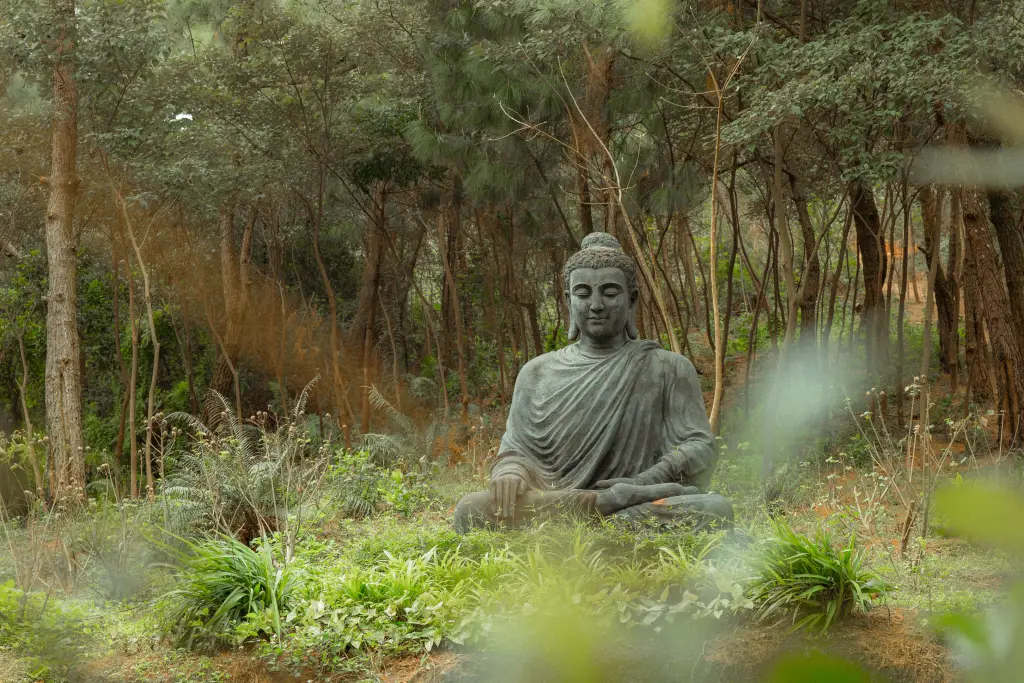Vipassana meditation, an ancient mindfulness technique, has gained recognition as a powerful tool to cultivate self-awareness and inner peace. Rooted in Buddhist tradition, this practice, which translates to “special seeing,” focuses on the observation of thoughts and emotions without judgment or attachment. As a cornerstone of Buddhist meditation, Vipassana offers a multitude of benefits for individuals seeking mental clarity and spiritual growth. This is intended to be a simple but comprehensive guide to Vipassana meditation for beginners.
Ideal for beginners and experienced practitioners alike, Vipassana meditation emphasizes building a sustainable and balanced practice compatible with day-to-day life. The technique primarily involves maintaining a proper posture and following a breathing pattern, which can be mastered over time. By fostering an environment for self-observation, Vipassana encourages individuals to dissolve problems, clear the mind, and address underlying issues affecting their overall well-being.

Vipassana meditation can be practiced at home, during a structured course, or with a group of fellow meditators to enhance its effectiveness. Whether investing five minutes each day, an hour per week, or engaging in a longer, ten-day course, this transformative practice invites individuals to embark on a life-changing journey towards self-discovery and personal growth.
Vipassana Meditation: Origins and Background
Vipassana meditation, also known as insight meditation, has its roots in the Theravada school of Buddhism, which is the oldest surviving form of Buddhism. The practice originates from the teachings of Buddha, who emphasized mindfulness and clear seeing as crucial components of the path towards enlightenment.
The foundational texts of Theravada Buddhism, the Pali Canon, contain numerous references to insight meditation techniques. Over the centuries, the practice remained an essential aspect of monastic life and lay practice in countries like Myanmar, where it experienced a resurgence in the early 20th century.
In Myanmar, Vipassana meditation was further developed and popularized by notable teachers such as S.N. Goenka. Goenka, a Burmese-Indian teacher, played a significant role in the global spread of Vipassana, establishing numerous meditation centers around the world under the umbrella of Dhamma.org. These centers offer systematic courses in Vipassana meditation, helping practitioners develop mindfulness and self-awareness.
The primary focus of Vipassana meditation is to cultivate a deep understanding of reality through direct observation of one’s own physical and mental experiences. The practice emphasizes examining thoughts, emotions, and sensations without judgment. Through consistent practice, Vipassana aims to foster a transformative process that leads to the ultimate goal of enlightenment.
In summary, Vipassana meditation has a long and rich history within the Theravada Buddhist tradition. With its emphasis on mindfulness, self-awareness, and direct observation, the practice has played a significant role in the spiritual development of countless individuals around the world. Through organizations like Dhamma.org and the teachings of prominent figures like S.N. Goenka, Vipassana meditation continues to thrive as an accessible and transformative practice for individuals seeking greater insights and wisdom.
The Goals and Benefits of Vipassana Meditation
Vipassana meditation is aimed at helping individuals gain more control over their thoughts, minimize distraction, and cultivate a more spiritual life. As an ancient technique, it has attracted the attention of researchers and practitioners alike for its potential benefits in various aspects of mental health and well-being.
One of the primary goals of Vipassana meditation is to help individuals develop a clear and calm mind. By training the mind to focus on the present moment, it allows practitioners to gain a more profound understanding of their thoughts, emotions, and the realities of life. This improved self-awareness can lead to increased self-control, allowing individuals to better manage stress, anxiety, depression, and other mental health challenges.
Vipassana meditation has also been found to promote brain plasticity, the brain’s ability to change and adapt in response to new experiences. It is essential for learning, memory, and overall cognitive function, and consistent meditation practice may enhance these aspects in one’s daily life.
Another important benefit of Vipassana meditation is its potential role in overcoming addiction. Substance abuse and addiction often result from individuals attempting to cope with stress or negative emotions. Vipassana’s ability to reduce stress and anxiety can potentially aid those struggling with addiction by improving their ability to manage their emotions in a healthier way, leading to a decreased reliance on substances for relief.
Furthermore, Vipassana meditation can help individuals overcome the ego and develop a deeper understanding of one’s true nature. By cultivating insight and self-awareness, practitioners can better recognize the ego’s influence on their thoughts and actions, leading to increased empathy, compassion, and improved interpersonal relationships.
In summary, practicing Vipassana meditation offers numerous potential benefits, including improved self-control, reduced stress and anxiety, enhanced brain plasticity, support in overcoming addiction, and greater self-awareness. It is a valuable technique for those seeking to improve their overall mental health and well-being.

Key Concepts in Vipassana Meditation
Mindfulness
Vipassana meditation is an ancient mindfulness technique that involves observing one’s thoughts and emotions without judgment or dwelling on them. The primary focus is often on the breath, helping practitioners develop a strong sense of convergent focus restricted to a specific action and reaction in the body.
Equanimity
Equanimity is a core element of Vipassana meditation practice. It encourages individuals to remain objective and maintain a balanced state of mind. By practicing equanimity, learners can experience sensations without becoming attached to or overwhelmed by them, whether they are pleasant, unpleasant, or neutral.
Insight
Insight meditation, also known as Vipassana, focuses on developing an understanding of the true nature of reality. This approach emphasizes mindfulness of breathing (anapanasati) and aims to cultivate insight into the impermanent, unsatisfactory, and selfless nature of existence. This growing awareness leads to a deeper comprehension of the interdependence of all things and can contribute to personal growth and transformation.
Awareness
In Vipassana meditation, practitioners systematically move their attention from head to feet and vice versa, observing each part of the body by feeling all sensations encountered. This heightened sense of awareness offers an opportunity to become more in tune with one’s physical and emotional states, ultimately leading to a greater sense of presence and intentionality in everyday life. By cultivating this awareness, individuals can experience increased self-mastery and well-being.

Preparing for Vipassana Meditation
Creating an Environment
To begin your Vipassana meditation practice, designate a quiet space where you can meditate without distractions. Having a dedicated space for meditation can help set the proper mindset and make it easier to maintain a regular practice. The environment plays a crucial role in deepening the meditation experience, so make sure the location is clean, clutter-free, and calming. You may add items like cushions, blankets, or candles to create a comfortable and relaxing atmosphere.
The Right Posture
When practicing Vipassana meditation, it is essential to find a suitable posture that allows you to remain still and focused. Most practitioners sit on a cushion or chair with their legs crossed and hands resting on their lap or knees. The back should be straight but not tense, and the neck and shoulders should be relaxed. One of the key meditation techniques in Vipassana is maintaining awareness of the breath, so ensure that your chest is open, allowing you to breathe freely without strain.
Here are a few popular meditation postures:
- Sitting cross-legged
- Sitting on a cushion, folded blanket, or meditation bench
- Sitting on a chair with feet flat on the ground
Comfort and Clothing
To fully focus on your Vipassana meditation practice, wear comfortable and non-restrictive clothing. Loose-fitting garments allow you to breathe easily, and garments made of breathable materials, such as cotton or linen, are most suitable. It is also necessary to maintain a steady body temperature because extreme heat or cold can be distracting during meditation. If needed, adjust your clothing or add blankets to stay comfortable.
As a beginner in Vipassana meditation, start with short sessions, about 5-10 minutes each, gradually increasing the duration to 15 minutes or longer as you become more familiar with the practice. By creating a comfortable environment, choosing the right posture, and wearing appropriate clothing, you can set the stage for a fruitful meditation practice that can lead to greater self-awareness and insight.
Vipassana Meditation Steps for Beginners
Anapanasati: Focus on Breathing
To begin Vipassana meditation, start by focusing on your breathing. Inhale and exhale through your nostrils, paying attention to the sensations each breath creates. On inhaling, let your lungs fill up completely, and allow your belly to expand. On exhaling, release the breath gently and fully. This initial focus on breath will help build concentration and awareness.
Body Sensations and Feelings
As your concentration deepens, shift your awareness to sensations throughout your body. You might notice aches, tingles, warmth, or other physical sensations. Don’t try to change these feelings, but simply observe and acknowledge them. This awareness of your body’s sensations helps you understand the impermanent nature of things and keeps you present in the moment.
Observing Thoughts
It is natural for thoughts to arise during meditation. Instead of attempting to suppress them, observe the thoughts as they come and go. Notice as they arise, stay a while, and eventually disappear. This mindful observation will help you recognize that thoughts are transient and can be released without attachment.
Acceptance and Letting Go
As you observe your breath, sensations, and thoughts during Vipassana meditation, cultivate a sense of acceptance and letting go. Accept whatever arises without judgment, and let go of any desire to control or change it. This attitude of acceptance and release will help you develop equanimity and deepen your meditation practice.

Common Challenges and Solutions
Dealing with Distractions
In Vipassana meditation, beginners often face the challenge of distractions, be it external noises or wandering thoughts. One solution is to approach these distractions with a non-judgmental and accepting attitude. When a distraction occurs, acknowledge it, and gently bring the attention back to the breath or the body sensations that one is observing.
Another technique to manage distractions is to use them as objects of meditation. For example, when a sound distracts the meditator, they can observe and explore the sensation of hearing. This helps to maintain self-observation and cultivate a deeper understanding of the present moment experience.
Maintaining Consistency
For beginners, maintaining consistency in their Vipassana practice can be challenging. It is essential to create a routine or schedule for regular practice to overcome this hurdle. Here are a few suggestions to help build consistency:
- Set a specific time and place for meditation each day.
- Start with a manageable duration and gradually increase it as the practice deepens.
- Use reminders or apps to help stay on track with the practice.
- Surround oneself with supportive people, such as friends or meditation groups, to stay motivated.
Cultivating Patience
Vipassana meditation can be a slow process, and cultivating patience is essential for the practitioner. To develop patience, one can:
- Focus on small, incremental progress, rather than expecting immediate or dramatic results.
- Remind oneself of the long-term benefits of the practice and the impermanent nature of distractions and challenges.
- Practice self-compassion and acceptance, understanding that meditation is an ongoing journey where ups and downs are natural.
By applying these strategies, beginners can effectively manage the common challenges of Vipassana meditation, such as dealing with distractions, maintaining consistency, and cultivating patience. This, in turn, will pave the way for a steady and fruitful meditation practice.
Vipassana Courses and Resources
Vipassana meditation, a Buddhist meditation technique, focuses on the connection between mind and body to cultivate self-awareness and mindfulness. In this section, we cover resources and options for those interested in learning and practicing Vipassana meditation.
Finding a Teacher
Having a knowledgeable and experienced teacher is crucial for learning proper Vipassana meditation techniques. Teachers can help create a strong foundation for your practice, which will ultimately help you develop your skills more effectively. Many experienced Vipassana meditation practitioners and educators can be found through local meditation centers, Buddhist organizations, or online communities.
Retreats and Courses
Vipassana meditation courses and retreats are often structured around a specific length of time, such as 10-day residential courses, where participants fully immerse themselves in the practice. These courses usually provide an environment suited for developing one’s meditation skills and understanding of the technique. Such retreats include:
- Vipassana Fellowship Meditation Course: A 10-week online course in mindfulness meditation based on the serenity and insight traditions of early Buddhism. The course typically starts at the beginning of the year, but more details can be found on their website.
- Dhamma.org: This website offers 10-day residential Vipassana meditation courses worldwide, covering the basics of the technique, enabling participants to experience its benefits. All courses are offered solely on a donation basis, and no fees are charged for accommodations or food.
To maintain the energy and connection to the practice, participants are encouraged to establish a daily Vipassana meditation routine at home after completing a course, which often includes sitting every morning and evening.
Here is a guided Vipassana meditation for beginners video:
In conclusion, Vipassana meditation is a powerful and transformative practice that requires guidance, dedication, and persistence to fully experience its benefits. By utilizing available resources and engaging in regular practice, beginners can develop a deeper understanding of the connection between their mind and body and cultivate the mindfulness that lies at the heart of Vipassana meditation.
